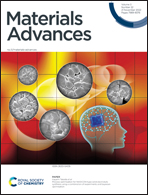Immobilization of molecular complexes on graphitized carbon cloth as stable and hybrid electrocatalysts for enhanced hydrogen evolution reaction and oxygen evolution reaction†
Abstract
The search for an environment friendly, sustainable and cost-effective catalyst used in electrochemical water splitting via the hydrogen evolution reaction (HER) has generated considerable interest in renewable energy research worldwide. In the current study, we report cost-effective and easily synthesizable 2-thioureidobenzothiazole (BTT) metal complexes (M = Pd, Co, Ni) as dual and efficient electrocatalysts for HER and OER applications in acidic and alkaline conditions, respectively. The hybrid molecular catalysts were synthesized by integrating transition metal complexes with graphitized carbon cloth (GrCC) as the carbon support. The pristine Pd(II)BTT complex exhibited enhanced hydrogen evolution activity with an applied overpotential value of 178 mV (vs. RHE) and a significantly lower Tafel slope value of 73.74 mV per decade in 0.5 M H2SO4 solution. The high catalytic activity of the Pd(II)BTT complex can be ascribed to the strong affinity of the Pd metal ion towards H2. The Ni(II)BTT/GrCC hybrid catalyst for the HER exhibited an overpotential of 335 mV (vs. RHE) to drive a current density of 10 mA cm−2 and was found to be superior vis-a-vis the pristine nickel complex. The enhanced catalytic activity of the hybrid catalyst is due to the conducting and porous nature of the graphitized carbon cloth. For OER activity, the pristine Ni(II)BTT complex exhibited a very low overpotential value of 250 mV to drive a current density of 10 mA cm−2 and gave a low Tafel slope value of 93 mV per decade. The cost-effective and robust nickel complex as a novel electrocatalyst was found to be very effective for both HER and OER applications. This work paves the way for a new avenue to combine molecular catalysts with effective carbon supports for energy storage applications.



 Please wait while we load your content...
Please wait while we load your content...